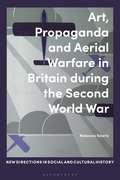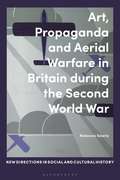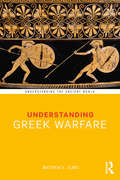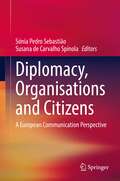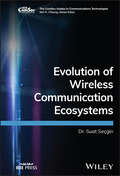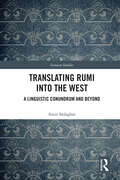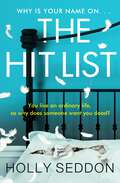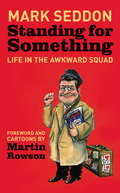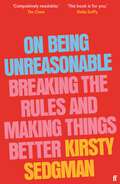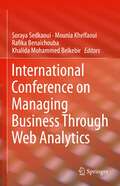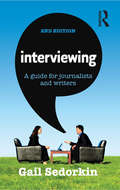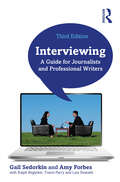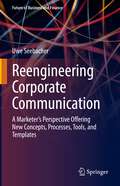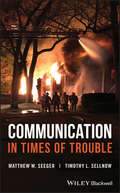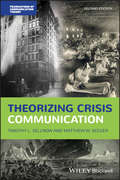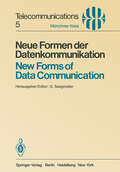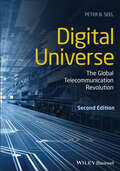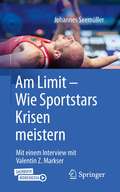- Table View
- List View
Art, Propaganda and Aerial Warfare in Britain during the Second World War (New Directions in Social and Cultural History)
by Rebecca SearleThe War Artists' Advisory Committee (WAAC) were responsible for the production of some of the most iconic images of the Second World War. Despite its rich historical value, this collection has been poorly utilised by historians and hasn't been subjected to the levels of analysis afforded to other forms of wartime culture. This innovative study addresses this gap by bringing official war art into dialogue with the social, economic and military histories of the Second World War. Rebecca Searle explores the tensions between the documentarist and propagandistic roles of the WAAC in their representation of aerial warfare in the battle for production, the Battle of Britain, the Blitz and the bombing of Germany. Her analyses demonstrate that whilst there was a strong correlation between war art and propaganda, the WAAC depicted many aspects of experience that were absent from wartime propaganda, such as class divisions within the services, gendered hierarchies within industries, civilian death and the true nature of the bombing of Germany. In addition, she shows that propagandistic constructions were not entirely separate from lived experience, but reflected experience and shaped the way that individuals made sense of the war. Accessibly written, highly illustrated and packed with valuable examples of the use of war art as historical source, this book will enhance our understanding of the social and cultural history of Britain during the Second World War.
Art, Propaganda and Aerial Warfare in Britain during the Second World War (New Directions in Social and Cultural History)
by Rebecca SearleThe War Artists' Advisory Committee (WAAC) were responsible for the production of some of the most iconic images of the Second World War. Despite its rich historical value, this collection has been poorly utilised by historians and hasn't been subjected to the levels of analysis afforded to other forms of wartime culture. This innovative study addresses this gap by bringing official war art into dialogue with the social, economic and military histories of the Second World War. Rebecca Searle explores the tensions between the documentarist and propagandistic roles of the WAAC in their representation of aerial warfare in the battle for production, the Battle of Britain, the Blitz and the bombing of Germany. Her analyses demonstrate that whilst there was a strong correlation between war art and propaganda, the WAAC depicted many aspects of experience that were absent from wartime propaganda, such as class divisions within the services, gendered hierarchies within industries, civilian death and the true nature of the bombing of Germany. In addition, she shows that propagandistic constructions were not entirely separate from lived experience, but reflected experience and shaped the way that individuals made sense of the war. Accessibly written, highly illustrated and packed with valuable examples of the use of war art as historical source, this book will enhance our understanding of the social and cultural history of Britain during the Second World War.
Understanding Greek Warfare (Understanding the Ancient World)
by Matthew A. SearsUnderstanding Greek Warfare offers a wide-ranging survey of Greek warfare, from the Mycenaeans through to the Hellenistic kingdoms’ clashes with Rome. Each chapter provides an overview of a particular theme and historical period, and a detailed discussion of the relevant sources, both ancient and modern. This volume covers not only the development of equipment, tactics, strategy, and the major wars of Greek history – the "drums and trumpets" – it also examines the political, social, and cultural importance of warfare in each period. Each chapter outlines major scholarly debates, such as the true nature of hoplite battle and whether Alexander the Great had a strategic vision beyond conquest, and includes several short selections from the primary literary evidence. Readable yet scholarly, this book is an ideal companion to courses on Greek warfare and society, and offers detailed suggestions for further reading and research. Understanding Greek Warfare will be a crucial resource for students of war in the ancient Greek world, and of the ancient Greeks in general.
Diplomacy, Organisations and Citizens: A European Communication Perspective
by Sónia Pedro Sebastião Susana de Carvalho SpínolaThis book uses an innovative interdisciplinary approach to explain how communication is a necessary condition for diplomacy in a digital and relationship-driven world. Divided into three parts, it highlights the importance of communication strategies and processes in contemporary society and in current global socio-political events in general, particularly within the field of diplomacy. The first part discusses the main theoretical debates that shaped the central concepts of the project, while the second part of the book presents further practical approaches and examples of diplomatic practice. Lastly, the third part focuses on pedagogical and methodological approaches, which can be useful in diplomacy and communication classes and for the implementation of a European curriculum. This interdisciplinary book will appeal to students, researchers, policy-makers, and practitioners from various disciplines, including international relations, political science, business, and communication.
Evolution of Wireless Communication Ecosystems (The ComSoc Guides to Communications Technologies)
by Suat SecginEvolution of Wireless Communication Ecosystems Understand a world transformed by wireless communication with this groundbreaking guide Since the advent of the internet, few technologies have proven more transformative than wireless communication. Never have we lived in a more comprehensively connected world, with the cloud and the coming sixth generation (6G) of wireless technology creating a vast and interconnected communications infrastructure. Global citizens of this newly interconnected reality are grappling like never before with its many challenges. Evolution of Wireless Communication Ecosystems provides readers with a history of wireless communication and a thorough overview of emerging frontiers. It traces wireless communication from the first generation through to the current fifth before surveying the current state of wireless technology and the ongoing research into 6G. The result is a book that understands wireless communication for the first time as an ecosystem, endlessly interconnected, growing, and boundlessly complex, but made intelligible by this highly readable introduction. Readers will also find: Detailed explanations of the journey starting from 1G to 6G Descriptions the infrastructure of 4G, 5G, and 6G systems, this all-connected communication ecosystem, the sub-components of this ecosystem, and the relationship among them Depictions of events seen in the capillaries of the communication echo system that show switching techniques, modulation, and multiplexing techniques Coverage of access techniques, protocols, the methods used in M2M and IoT connections at the endpoints, and security issues that show how they are an integral part of wireless communication infrastructure Evolution of Wireless Communication Ecosystems from 1G to 6G is an essential reference for wireless and telecommunications professionals, as well as researchers interested in 6G or other emerging wireless technologies.
Evolution of Wireless Communication Ecosystems (The ComSoc Guides to Communications Technologies)
by Suat SecginEvolution of Wireless Communication Ecosystems Understand a world transformed by wireless communication with this groundbreaking guide Since the advent of the internet, few technologies have proven more transformative than wireless communication. Never have we lived in a more comprehensively connected world, with the cloud and the coming sixth generation (6G) of wireless technology creating a vast and interconnected communications infrastructure. Global citizens of this newly interconnected reality are grappling like never before with its many challenges. Evolution of Wireless Communication Ecosystems provides readers with a history of wireless communication and a thorough overview of emerging frontiers. It traces wireless communication from the first generation through to the current fifth before surveying the current state of wireless technology and the ongoing research into 6G. The result is a book that understands wireless communication for the first time as an ecosystem, endlessly interconnected, growing, and boundlessly complex, but made intelligible by this highly readable introduction. Readers will also find: Detailed explanations of the journey starting from 1G to 6G Descriptions the infrastructure of 4G, 5G, and 6G systems, this all-connected communication ecosystem, the sub-components of this ecosystem, and the relationship among them Depictions of events seen in the capillaries of the communication echo system that show switching techniques, modulation, and multiplexing techniques Coverage of access techniques, protocols, the methods used in M2M and IoT connections at the endpoints, and security issues that show how they are an integral part of wireless communication infrastructure Evolution of Wireless Communication Ecosystems from 1G to 6G is an essential reference for wireless and telecommunications professionals, as well as researchers interested in 6G or other emerging wireless technologies.
Translating Rumi into the West: A Linguistic Conundrum and Beyond (Iranian Studies)
by Amir SedaghatFocusing on Rumi, the best-selling Persian mystical poet of the 13th century, this book investigates the reception of his work and thought in North America and Europe – and the phenomenon of ‘Rumimania’ – to elucidate the complexities of intercultural communication between the West and the Iranian and Islamic worlds. Presenting tens of examples from the original and translated texts, the book is a critical analysis of various dimensions of this reception, outlining the difficulties of translating the text but also exploring how translators of various times and languages have performed, and explaining why the quality of reception varies. Topics analysed include the linguistic and pragmatic issues of translation, comparative stylistics and poetics, and non-textual factors like the translator’s beliefs and the political and ideological aspects of translation. Using a broad theoretical framework, the author highlights the difficulties of intercultural communication from linguistic, semiotic, stylistic, poetic, ethical, and sociocultural perspectives. Ultimately, the author shares his reflections on the semiotic specificities of Rumi’s mystical discourse and the ethics of translation generally. The book will be valuable to scholars and students of Islamic philosophy, Iranian studies, and translation studies, but will appeal to anyone interested in the cultural dichotomies of the West and Islam.
Translating Rumi into the West: A Linguistic Conundrum and Beyond (Iranian Studies)
by Amir SedaghatFocusing on Rumi, the best-selling Persian mystical poet of the 13th century, this book investigates the reception of his work and thought in North America and Europe – and the phenomenon of ‘Rumimania’ – to elucidate the complexities of intercultural communication between the West and the Iranian and Islamic worlds. Presenting tens of examples from the original and translated texts, the book is a critical analysis of various dimensions of this reception, outlining the difficulties of translating the text but also exploring how translators of various times and languages have performed, and explaining why the quality of reception varies. Topics analysed include the linguistic and pragmatic issues of translation, comparative stylistics and poetics, and non-textual factors like the translator’s beliefs and the political and ideological aspects of translation. Using a broad theoretical framework, the author highlights the difficulties of intercultural communication from linguistic, semiotic, stylistic, poetic, ethical, and sociocultural perspectives. Ultimately, the author shares his reflections on the semiotic specificities of Rumi’s mystical discourse and the ethics of translation generally. The book will be valuable to scholars and students of Islamic philosophy, Iranian studies, and translation studies, but will appeal to anyone interested in the cultural dichotomies of the West and Islam.
The Hit List: 'Sinister, clever and utterly compelling' Lesley Kara
by Holly SeddonWhat would you do if you found your own name on a hit list? Seddon addresses this terrifying question in an explosive novel. One of the most exciting, brave and clever books I have ever read. The Hit List is my book of the year. Gillian McAllister, author of How to DisappearThis novel kept me guessing to the end. A twisty, intelligent thrill ride. Excellent! Will Dean, author of Black River This meticulously plotted novel will suck you ever deeper into its dark underbelly. Sinister, clever and utterly compelling. Lesley Kara, author of WHO DID YOU TELL?On the anniversary of her husband's accidental death, Marianne seeks comfort in everything Greg left behind. She wears his shirt and cologne, reads their love letters and emails. Soon she's following his footsteps across the web, but her desperation to cling to any trace of him leads her to the dark web. And a hit list with her name on it. To try to save herself from Sam, the assassin hired to kill her, Marianne must first unpick the wicked web in which Greg became tangled. Was Greg trying to protect her or did he want her dead?A gripping and emotional ebook bestseller about a woman who discovers a shocking secret about her late husband that will hook you from the first pageLoved THE HIT LIST? You can download Holly Seddon's latest twisty thriller THE SHORT STRAW now, an atmospheric mystery about three sisters stranded in an abandoned manor house later at night.
Standing for Something: Life in the Awkward Squad
by Mark SeddonMark Seddon is best known in Britain as a leading member of the Awkward Squad, a thorn in the flesh of New Labour as editor of Tribune, house magazine of the Left, for over a decade. In that role and as a member of Labour's National Executive Committee, he scurried around the corridors of power, gaining a unique perspective on the activities of Blair, Brown and Mandelson - and of less familiar figures who played their part in the story of New Labour. Standing for Something is the record of an unusual political life played out on an international stage.
On Being Unreasonable: Breaking the Rules and Making Things Better
by Kirsty SedgmanManners, order and respect... these are all ideals we subscribe to. In opposed positions, we ought to be able to 'agree to disagree'. Today's world is built from structures of standards and reason, but it is imperative to ask who constructed these norms, and why. We are more divided than ever before-along lines of race, gender, class, disability-and it's time to question who benefits the most. What if our propensity to measure human behaviour against rules and reason is actually more problematic than it might seem? Kirsty Sedgman shows how power dynamics and the social biases involved have resulted in a wide acceptance of what people should and shouldn't do, but they create discriminatory realities and amount to a societal façade that is dangerous for genuine social progress. From taking the knee to breastfeeding in public, from neighbourhood vigilantism to the Colston Four-and exploring ideas around ethics, justice, society, and equality along the way-Sedgman explores notions of civility throughout history up to now.On Being Unreasonable mounts a vital and spirited defence of why and how being unreasonable can help improve the world. It examines and parses the pros and cons of our rules around reason, but leaves us with the rousing question: What if behaving unreasonably at times might be the best way to bring about meaningful change that is long overdue?
International Conference on Managing Business Through Web Analytics
by Soraya Sedkaoui Mounia Khelfaoui Rafika Benaichouba Khalida Mohammed BelkebirThis book presents the proceedings of the International Conference on Managing Business through Web Analytics (ICMBWA 2021). The conference provides a global forum for sharing knowledge and results in theory, methodology, and applications of Web Analytics and their role in the formulation and the orientation of businesses’ strategies. The aim of the conference is to provide a platform for researchers and practitioners from both academia and industry to meet and share their works in the field. Is an excellent resource for scholars, experts and industrial in the fields represented, as well as Ph.D. students seeking an entryway into current research in data analytics, Web analytics, machine learning algorithms, and their various applications within businesses.
Interviewing: A guide for journalists and writers
by Gail Sedorkin'The quintessential catch-all of journalism interviewing with tips, techniques and tales covering all interviewing forms in one easy-to-read volume.' - Leo Bowman in Australian Studies in JournalismGood interviewing is the key to good reporting and great stories. It's a difficult skill to acquire and it can be stressful, but you can learn how to approach a total stranger and elicit information on a topic about which you know nothing.In the second edition of this widely used guide, experienced journalist Gail Sedorkin shows you step by step how to manage the interview process. She explains how to prepare, and what to do when you don't have time to do any research. She outlines the difference between 'soft' and 'hard' interviews, how to use digital tools effectively, and how to make the most of any interview situation.With tips and examples from leading journalists, and covering basic to advanced techniques, Interviewing is an essential guide for journalists, researchers and writers.
Interviewing: A guide for journalists and writers
by Gail Sedorkin'The quintessential catch-all of journalism interviewing with tips, techniques and tales covering all interviewing forms in one easy-to-read volume.' - Leo Bowman in Australian Studies in JournalismGood interviewing is the key to good reporting and great stories. It's a difficult skill to acquire and it can be stressful, but you can learn how to approach a total stranger and elicit information on a topic about which you know nothing.In the second edition of this widely used guide, experienced journalist Gail Sedorkin shows you step by step how to manage the interview process. She explains how to prepare, and what to do when you don't have time to do any research. She outlines the difference between 'soft' and 'hard' interviews, how to use digital tools effectively, and how to make the most of any interview situation.With tips and examples from leading journalists, and covering basic to advanced techniques, Interviewing is an essential guide for journalists, researchers and writers.
Interviewing: A Guide for Journalists and Professional Writers
by Gail Sedorkin Amy ForbesThis is an essential guide to the art of interviewing, with checklists, tips and examples from leading journalists and PR specialists, covering basic to advanced techniques. Sedorkin and Forbes provide a comprehensive, step-by-step overview of how to manage the interview process. They cover: best practice for preparing for an interview (and what to do when you don’t have time to); the differences between news and feature interviews (for print and broadcast); techniques to break the ice and navigate tricky and sensitive interviewees and topics; tips on staying safe when operating in dangerous situations; how best to utilise digital tools to make the most of any interview situation. This third edition builds on the popular previous edition and expands its scope to include the disciplines of public relations and professional writing, areas where practitioners require the interviewing skills of journalists to produce materials for the media. It also contains new and updated global examples/case studies and excerpts, including remote interviewing technologies and techniques developed and adopted as a response to the disruptions of the COVID-19 pandemic. Additional pedagogical features have been added to help facilitate learning, like end of chapter exercises, checklists, videos and top tips. This book provides the tools for students and professionals to hone the necessary skill set to excel at interviewing. It is an ideal and important resource for those studying or active in the fields of journalism and PR, and those undertaking professional writing courses.
Interviewing: A Guide for Journalists and Professional Writers
by Gail Sedorkin Amy ForbesThis is an essential guide to the art of interviewing, with checklists, tips and examples from leading journalists and PR specialists, covering basic to advanced techniques. Sedorkin and Forbes provide a comprehensive, step-by-step overview of how to manage the interview process. They cover: best practice for preparing for an interview (and what to do when you don’t have time to); the differences between news and feature interviews (for print and broadcast); techniques to break the ice and navigate tricky and sensitive interviewees and topics; tips on staying safe when operating in dangerous situations; how best to utilise digital tools to make the most of any interview situation. This third edition builds on the popular previous edition and expands its scope to include the disciplines of public relations and professional writing, areas where practitioners require the interviewing skills of journalists to produce materials for the media. It also contains new and updated global examples/case studies and excerpts, including remote interviewing technologies and techniques developed and adopted as a response to the disruptions of the COVID-19 pandemic. Additional pedagogical features have been added to help facilitate learning, like end of chapter exercises, checklists, videos and top tips. This book provides the tools for students and professionals to hone the necessary skill set to excel at interviewing. It is an ideal and important resource for those studying or active in the fields of journalism and PR, and those undertaking professional writing courses.
Reengineering Corporate Communication: A Marketer’s Perspective Offering New Concepts, Processes, Tools, and Templates (Future of Business and Finance)
by Uwe SeebacherThis book employs the latest insights from modern marketing into the theory and practice of corporate communication, including the main stages and goals, and highlights the key potentials for the field. It briefly presents the essential features of the methodological and structural sciences in order to illustrate to the reader how, from a marketer's point of view, these new insights can be derived objectively, reliably, and validly for the field of corporate communication according to scientific criteria. The book then introduces the maturity model for modern corporate communication and describes which fields of activity must be gone through in order to be able to implement the change management process towards corporate communication excellence efficiently and effectively. Building on this, it introduces and defines the most important new concepts of corporate communication in the twenty-first century and thus clearly delineates the field of research for this corporate function in the coming years. The book goes on to address the important areas of IT and HR in order to provide a 360° view of the developments to be realized in the field of corporate communication. A “CC self-test” at the end of the book is intended to help the reader immediately recognize where their own organization stands and, against this backdrop, to be able to start the necessary activities towards corporate communication excellence immediately on the basis of the maturity model. “Prof. Dr. Uwe Seebacher takes us on a timely and informative read on what could be the biggest crisis for Corporate Communications – remaining stagnant in a time of great change. With rich context and fine detail, he illuminates the opportunities to reengineer Corporate Communications and quantify its role in truly impacting business. From the importance of predictive intelligence underpinned by authenticity and empathy to building trust, this book is a guide for successful business in the 21st Century. I highly recommend it.”Heidi Eusebio, Strategist and Executive Director, Edelman "Uwe Seebacher has once again demonstrated in a well-founded manner what methodological and structural science is capable of - namely, to precisely logically derive the long overdue process of change in the field of corporate communications and thereby make it comprehensible. But he also takes the important next step of operationalizing his thoughts in a directly measurable way by providing an easy applicable concrete process model for reengineering corporate communication with many tips, templates and inputs for HR and IT.“ Miguel Gimenez de Castro, Head Of Communications Spain, Portugal, Greece and Israel, IBM
Communication in Times of Trouble
by Matthew W. Seeger Timothy L. SellnowPresents the best practices of crisis communication and emergency risk communication This book covers crisis communication strategies and focuses on practical applications for effective management. It includes an extensive discussion of best practices in pre-crisis, crisis and post crisis stages. The book pays special attention to the needs of meeting the needs of diverse audiences and communicating in a responsive and responsible way. The principles are appropriate for many kinds of events including earthquakes, tornadoes, hurricanes, tsunamis, epidemics, and pandemics as well as industrial accidents, toxic spills, transportation disasters, fires and intentional events. In the first chapter, Communication in Times of Trouble introduces the concept of best practices and establishes their relevance for crisis communication and emergency risk communication. A chapter is dedicated to each of the ten best practices. In each chapter, the best practice is described, examples of successful and unsuccessful application of the best practice in both organizational crises and natural disasters/emergencies are provided, advice for practical application is given, and a summary is provided. The concluding chapter details the challenges and opportunities for developing and implementing a response strategy that includes the best practices as a whole. Focuses on application and explanation in crisis communication to benefit those with backgrounds in emergency management, risk management, political science, disaster sociology, and public health Covers natural, large-scale emergencies such as earthquakes, tornadoes, hurricanes, tsunamis, epidemics, and pandemics, which aren’t generally detailed in existing crisis communication texts Presents 10 best practices for dealing with emergencies: Process Approach; Pre-Event Planning; Partnerships; Public Concern; Honesty; Collaborate; Media access; Compassion; Uncertainty; Empowerment Communication in Times of Trouble will be of great interest to undergraduate students and practitioners in communication, public relations, public affairs, public information, public health, and emergency management.
Communication in Times of Trouble
by Matthew W. Seeger Timothy L. SellnowPresents the best practices of crisis communication and emergency risk communication This book covers crisis communication strategies and focuses on practical applications for effective management. It includes an extensive discussion of best practices in pre-crisis, crisis and post crisis stages. The book pays special attention to the needs of meeting the needs of diverse audiences and communicating in a responsive and responsible way. The principles are appropriate for many kinds of events including earthquakes, tornadoes, hurricanes, tsunamis, epidemics, and pandemics as well as industrial accidents, toxic spills, transportation disasters, fires and intentional events. In the first chapter, Communication in Times of Trouble introduces the concept of best practices and establishes their relevance for crisis communication and emergency risk communication. A chapter is dedicated to each of the ten best practices. In each chapter, the best practice is described, examples of successful and unsuccessful application of the best practice in both organizational crises and natural disasters/emergencies are provided, advice for practical application is given, and a summary is provided. The concluding chapter details the challenges and opportunities for developing and implementing a response strategy that includes the best practices as a whole. Focuses on application and explanation in crisis communication to benefit those with backgrounds in emergency management, risk management, political science, disaster sociology, and public health Covers natural, large-scale emergencies such as earthquakes, tornadoes, hurricanes, tsunamis, epidemics, and pandemics, which aren’t generally detailed in existing crisis communication texts Presents 10 best practices for dealing with emergencies: Process Approach; Pre-Event Planning; Partnerships; Public Concern; Honesty; Collaborate; Media access; Compassion; Uncertainty; Empowerment Communication in Times of Trouble will be of great interest to undergraduate students and practitioners in communication, public relations, public affairs, public information, public health, and emergency management.
Theorizing Crisis Communication (Foundations of Communication Theory Series)
by Matthew W. Seeger Timothy L. SellnowExplore the major theories within crisis communication, fully revised and updated Theorizing Crisis Communication provides a comprehensive and state-of-the-art review of both current and emerging theoretical frameworks designed to explain the development, management, and consequences of natural and human-caused crises. A critique of the many theoretical approaches of crisis communication, this volume provides readers with an in-depth understanding of the management, response, resolution, and significance of failures in corporate responsibility, as well as destructive global events such as pandemics, earthquakes, hurricanes, tsunamis, chemical spills, and terrorist attacks. This second edition contains new theories from related subfields and updated examples, references, and case examples. New chapters discuss metatheoretical considerations and theoretical advancements in the study of social media. Throughout the text, the authors highlight similarities, patterns, and relationships across different crisis types and offer insight into the application of theory in the real world. Integrating work from organizational studies, social sciences, public relations, and public health, this book: Covers a broad range of crisis communication theories, including those relevant to emergency response, risk management, ethics, resilience and crisis warning, development, and outcomes Presents theoretical frameworks based on research disciplines including sociology, psychology, applied anthropology, and criminal justice Provides clear and compelling examples of application of theory in contexts such as rhetoric, mass communication, social media, and warning systems Offers a systematic and accessible presentation of topics by explaining each theory, describing its applications, and discussing its advantages and drawbacks Theorizing Crisis Communication, Second Edition, is the perfect textbook for advanced undergraduate and graduate students of crisis and risk communication, and an importance reference for scholars, researchers, and practitioners in fields including crisis communication, emergency management, disaster studies, sociology, psychology, and anthropology.
Neue Formen der Datenkommunikation / New Forms of Data Communication: Vorträge des am 1./2. Juli 1980 in München abgehaltenen Symposiums / Proceedings of a Symposium Held in Munich July 1/2, 1980 (Telecommunications #5)
by G. SeegmüllerDigital Universe: The Global Telecommunication Revolution
by Peter B. SeelAn illuminating examination of the benefits and drawbacks of global, digital communication In this newly revised Second Edition of Digital Universe: The Global Telecommunication Revolution, journalism and digital telecommunication expert Peter B. Seel delivers a fascinating and insightful exploration of digital communication technologies and their substantial effects on contemporary life. This book traces the evolution of digital information and communication tools used around the world, from undersea telegraph cables to the newest mobile phones. Digital Universe introduces readers to important inventors, scientists, artists, and thinkers in its discussions of the history and socio-cultural effects of technology adoption. It offers an accessible tour of the global digital universe and provides new perspectives and critical observations on mediated human communication. The book also includes: A thorough introduction to digital communication, the internet, and the origins of the world wide web Comprehensive explorations of telecommunication and media convergence, including the profound effects of the adoption of wired and wireless technologies worldwide Practical discussions of internet control, cyberculture, and dystopian views -- including online censorship, the loss of personal privacy, surveillance capitalism, increasing data hacks, and cyberwarfare The book introduces an original concept, the Tao of Technology, that encourages readers to adopt an enhanced worldview of informed ambivalence toward the diffusion of new telecommunication technologies A new chapter on artificial intelligence (A.I.) explores its application in global telecommunication and examines the biases introduced by its creators In-depth examinations of new technologies, including alternative digital realities such as virtual and augmented realties, and their potential effects on the future of digital communication Perfect for undergraduate and graduate students in journalism, technical communication, speech communication, technology history, sociology, anthropology, computer information systems, and education; it provides the latest data on innovations in telecommunication. The second edition of Digital Universe: The Global Telecommunication Revolution will be an invaluable resource for anyone with an interest in the evolution of the internet, new telecommunication technologies, communication privacy and surveillance, the rise of social media, and the consequences of the diffusion of information and communication technologies.
Digital Universe: The Global Telecommunication Revolution
by Peter B. SeelAn illuminating examination of the benefits and drawbacks of global, digital communication In this newly revised Second Edition of Digital Universe: The Global Telecommunication Revolution, journalism and digital telecommunication expert Peter B. Seel delivers a fascinating and insightful exploration of digital communication technologies and their substantial effects on contemporary life. This book traces the evolution of digital information and communication tools used around the world, from undersea telegraph cables to the newest mobile phones. Digital Universe introduces readers to important inventors, scientists, artists, and thinkers in its discussions of the history and socio-cultural effects of technology adoption. It offers an accessible tour of the global digital universe and provides new perspectives and critical observations on mediated human communication. The book also includes: A thorough introduction to digital communication, the internet, and the origins of the world wide web Comprehensive explorations of telecommunication and media convergence, including the profound effects of the adoption of wired and wireless technologies worldwide Practical discussions of internet control, cyberculture, and dystopian views -- including online censorship, the loss of personal privacy, surveillance capitalism, increasing data hacks, and cyberwarfare The book introduces an original concept, the Tao of Technology, that encourages readers to adopt an enhanced worldview of informed ambivalence toward the diffusion of new telecommunication technologies A new chapter on artificial intelligence (A.I.) explores its application in global telecommunication and examines the biases introduced by its creators In-depth examinations of new technologies, including alternative digital realities such as virtual and augmented realties, and their potential effects on the future of digital communication Perfect for undergraduate and graduate students in journalism, technical communication, speech communication, technology history, sociology, anthropology, computer information systems, and education; it provides the latest data on innovations in telecommunication. The second edition of Digital Universe: The Global Telecommunication Revolution will be an invaluable resource for anyone with an interest in the evolution of the internet, new telecommunication technologies, communication privacy and surveillance, the rise of social media, and the consequences of the diffusion of information and communication technologies.
Video Traces for Network Performance Evaluation: A Comprehensive Overview and Guide on Video Traces and Their Utilization in Networking Research
by Patrick Seeling Frank H. Fitzek Martin ReissleinThis book provides a comprehensive introduction to video traces and their use in networking research. After first providing the basics of digital video and video coding, the book introduces video traces, covering the metrics captured in the traces, the trace generation, as well as the statistical characteristics of the video characterized in the traces.
Am Limit – Wie Sportstars Krisen meistern: Mit einem Interview mit Valentin Z. Markser
by Johannes SeemüllerMedaillen und Titel sind die Währung erfolgreicher Sportler. Wer ganz oben steht, wird von den Medien zum Star gemacht und von den Fans verehrt. Hierfür gehen Leistungssportler an ihre körperlichen und mentalen Grenzen – und oft darüber hinaus. In diesem Buch erzählen Olympiasieger, Weltmeister und Champions League-Sieger durch exklusiv geführte Interviews über ihre Leidenschaft für den Sport. Sie berichten aber auch ungeschminkt über die Schattenseiten. Leistungsdruck, Burnout, Schmerzen, Magersucht, Depressionen, Ängste – nichts ist ihnen fremd. Gerald Asamoah · Matthias Behr · Karla Borger · Timo Hildebrand · Ottmar Hitzfeld · Clara Klug · Michael Köllner · Dominik Nerz · Elisabeth Seitz · Frank Stäbler · Kristina Vogel Selten sprachen Spitzensportler so offen darüber, wie sie mit Rückschlägen und Krisen umgegangen sind. Das Buch enthält abrufbare Videoausschnitte aus den geführten Gesprächen. Ergänzt werden die Porträts durch ein ausführliches Interview mit Dr. Valentin Z. Markser, einem der renommiertesten deutschen Sportpsychiater.
